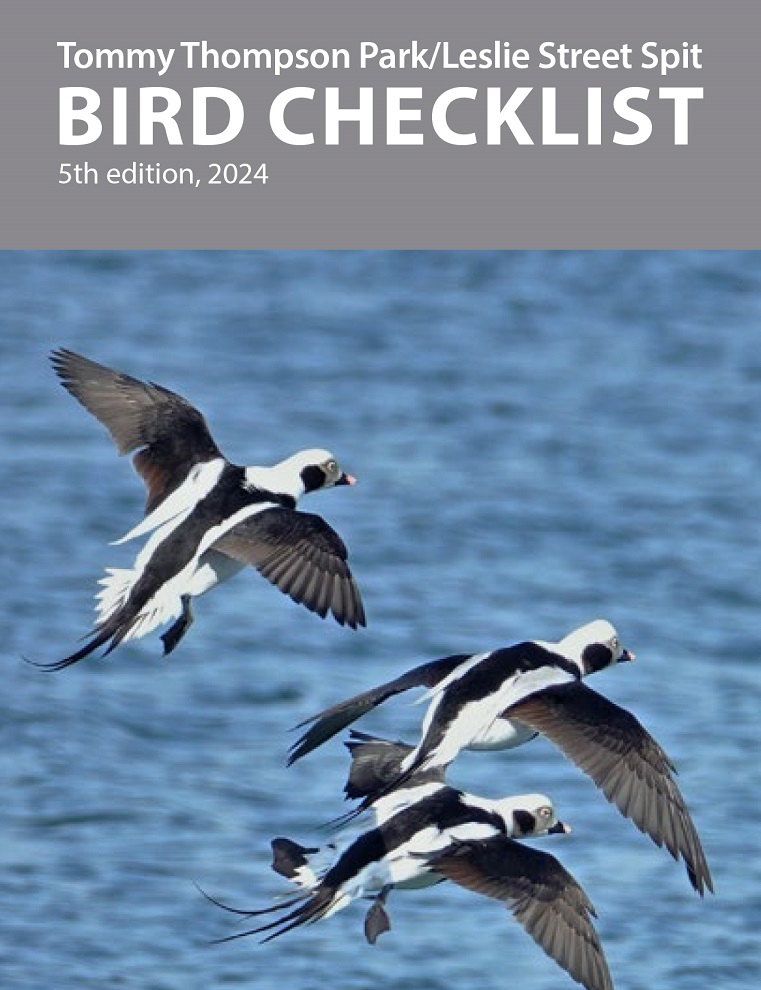Birds of Tommy Thompson Park
Tommy Thompson Park is an amazing spot for bird watching: 334 species of birds have been recorded at the park, including at least 55 breeding species.
Tommy Thompson Park is an important stopover during migration for many bird species that need to rest and refuel to continue their journey. In addition to many species of songbirds, the park also plays host to migrating raptors, waterfowl and shorebirds.
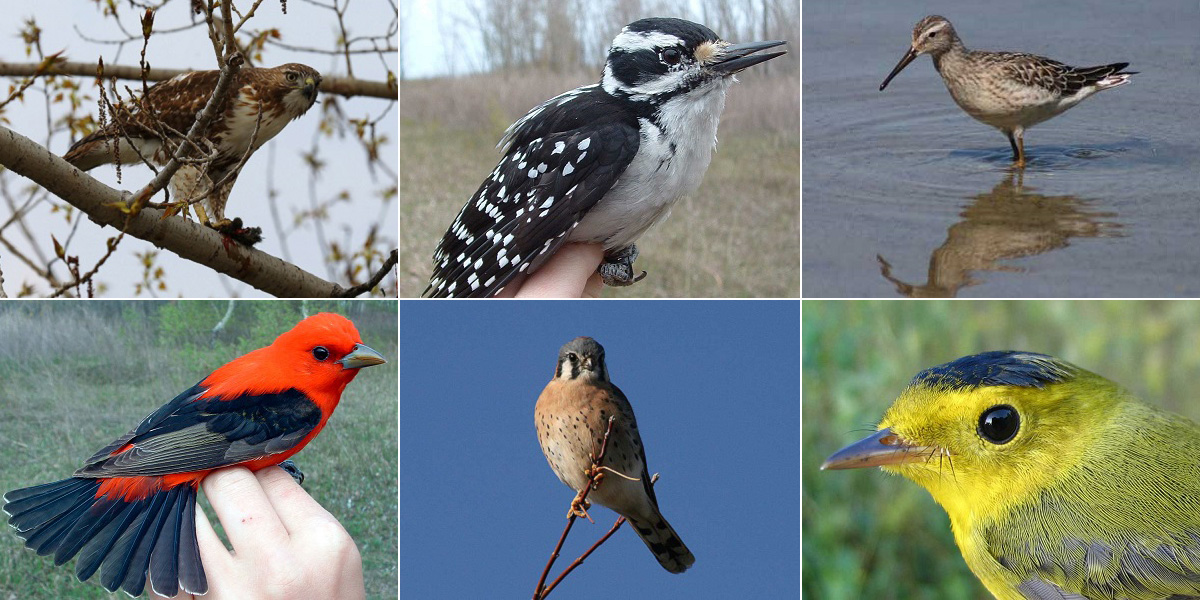
In 2000, Tommy Thompson Park was declared a Globally Significant Important Bird Area by BirdLife International. It earned this designation for:
- The globally significant numbers of nesting colonial waterbirds.
- The nationally significant numbers of waterfowl during migration and over winter.
- The large concentrations of songbirds during migration.
The Tommy Thompson Park Bird Research Station (TTPBRS) is dedicated to the understanding and protection of birds and their habitats through monitoring, education and research.
Enhancing Bird Habitats
Bird habitat enhancements at Tommy Thompson Park have targeted a number of species:
- Around the Cell One Wetland, a bank was constructed to target nesting bank swallows and was an immediate success — swallows were observed digging nests within days of its completion.
- Small bird boxes throughout the site are intended for use by tree swallows and eastern bluebirds.
- American kestrel, owl and waterfowl boxes for cavity nesters have been installed in various locations throughout the park.
- Duck platforms or tubes have been situated in strategic locations around the Cell One Wetland to encourage marsh-nesting waterfowl.
- Habitat brush piles throughout the park create micro-climates and are used by various bird species for nesting and foraging.
- Snags installed in various locations provide perching spots for raptors, and have also hosted nesting northern flickers.

Above, left to right: habitat for bank swallows at Cell One Wetland; a small bird box for tree swallows; a tube for marsh-nesting waterfowl
One of the most successful projects was the introduction of Common Tern reef rafts. While these are still in use in Cell Two and Embayment D, we have created an island in Cell One to accommodate breeding terns. This proved an immediate success, as terns colonized the island within first year after completion.
Our efforts to support the breeding of Caspian terns have met with mixed results: record productivity in some years, disappointment in others. We will continue to enhance Caspian tern habitat and monitor breeding to help ensure the success of this species at the park.
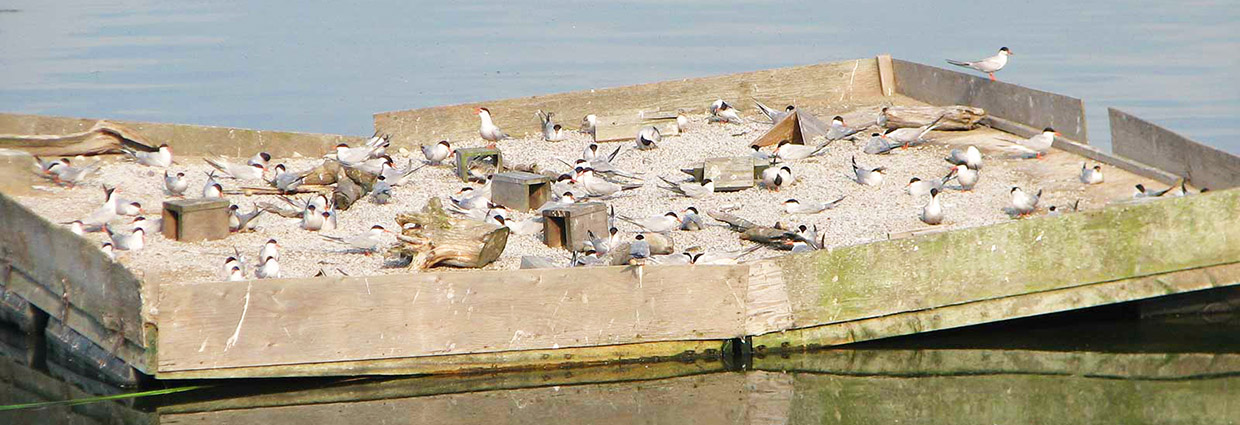
A tern raft at Embayment D
The most recent endeavour to target birds is the Shorebird Habitat Creation project.
Shorebirds in this region face a number of threats, including habitat loss. Our new Shorebird Habitat Creation project in the Toplands area will provide critical foraging and loafing habitat for both resident and migrating shorebirds. Shallow ponds with open mudflats will have water depth managed to maximize the production and diversity of invertebrates. Water depth can also be altered to benefit other species, especially post-migration.
Future habitat enhancements may include nesting platforms for Black Terns; upland nesting opportunities for waterfowl, and encouragement of Trumpeter Swan nesting through control of the introduced Mute Swan.
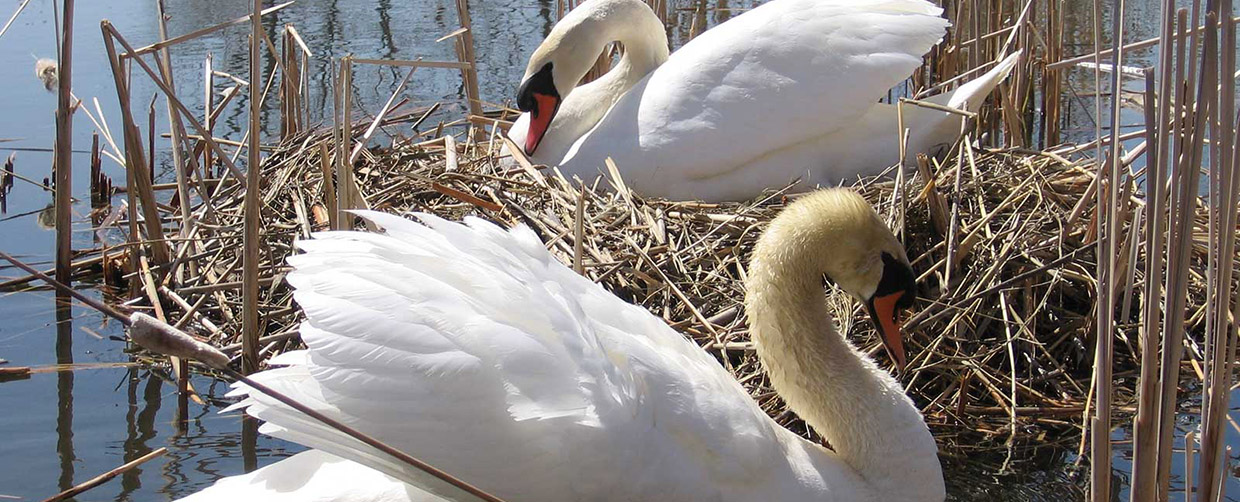
A pair of mute swans
Colonial Waterbirds
Tommy Thompson Park hosts significant numbers of birds that nest in large groups or colonies. There are eight different species of colonial birds that nest or have nested at the park.
Colonial Waterbirds: FAST FACTS
(Hover over the images to view)
The Spit is home to one of the largest breeding Ring-billed Gull (Larus delawarensis) colonies in the world — at its peak, about 6% of the estimated global breeding population.
HERRING GULLS (Larus argentatus) are frequent nesters among the ring-billed gulls, but have not nested in large numbers.
BLACK-CROWNED NIGHT HERONS (Nycticorax nycticorax) nest at Tommy Thompson Park — averaging, over the long term, approximately 17% of the estimated national breeding population. When their numbers peaked in 2000, the night herons represented nearly one-third of the estimated Canadian breeding population.
DOUBLE-CRESTED CORMORANTS (Phalocrocorax auritus) began nesting at Tommy Thompson Park in 1990 and have since become a common sight throughout Toronto Harbour. The Tommy Thompson Park cormorant colony is the largest in North America, numbering 13,275 nesting pairs in 2016.
There are an average of 8 GREAT EGRET (Ardea alba) nests mixed in with cormorants and night-herons.
Since 1976, COMMON TERNS (Sterna hirundo) have nested in significant numbers on artificial breeding platforms, or “reef rafts,” and are now also nesting on an island we created in Cell One (see above). At its peak, the common tern breeding population at the park represented 1.8% of the estimated North American population.
Monitoring Colonial Birds
Toronto and Region Conservation Authority (TRCA) conducts annual counts of double-crested cormorants and black-crowned night herons to track changes in populations and nesting areas. Upon completion of nesting the forests are also monitored to measure any impacts the birds have upon the health of trees.
Ring-billed gull management is an ongoing effort. Since the 1970s, TRCA has used various techniques to manage the population. Without such efforts, it has been estimated that the gull population at Tommy Thompson Park would now total approximately 180,000 pairs.
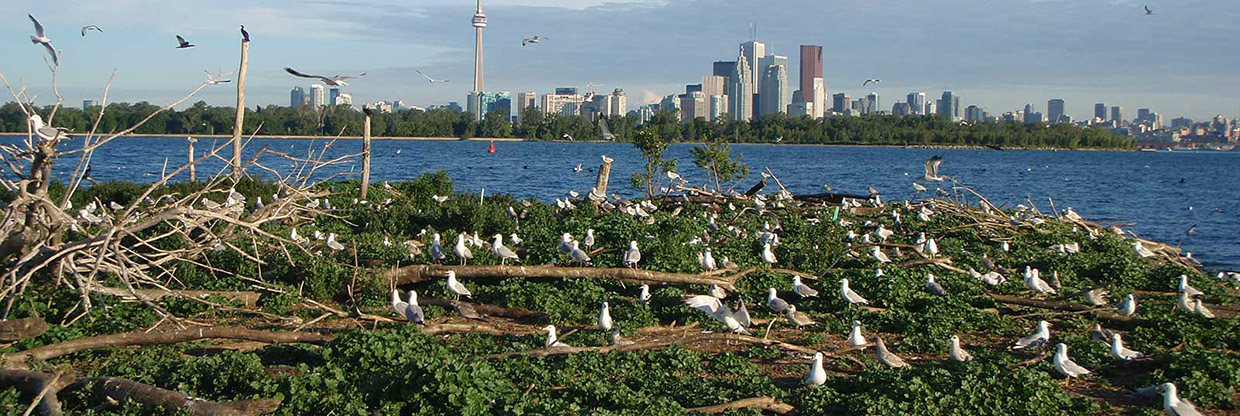
We also monitor common tern and Caspian tern populations by counting nests and noting any obvious areas of stress.
TRCA works in cooperation with the Canadian Wildlife Service (CWS) to count ring-billed gulls and herring gulls every five years. TRCA also partners with the CWS on long-term contaminant monitoring, as well as other colonial waterbird studies.
Many other organizations conduct research at Tommy Thompson Park as well, often focusing on colonial waterbirds. Recent projects have included dietary studies of double-crested cormorants and an investigation of the interactions between double-crested cormorants and black-crowned night herons.
Cormorant Management
Double-crested Cormorants are a native colonial waterbird that are expected to be found along the Toronto waterfront where there is plenty of food (fish) and nesting opportunities. They nest in large numbers in trees and on the ground. Tree nesting eventually results in the death of nest trees because of high acidity in cormorant excrement.
Cormorants were almost extirpated from the Great Lakes in the 1970s due to contaminants, overfishing, and poaching. Environmental conditions have since improved, and cormorant populations have recovered.
Tommy Thompson Park is home to one of the largest Double-crested Cormorant colonies in North America. Since 2009, TRCA has managed the cormorant population at Tommy Thompson Park to reduce their impact on trees. The management strategy was developed though consultation with a stakeholder advisory group and the public.
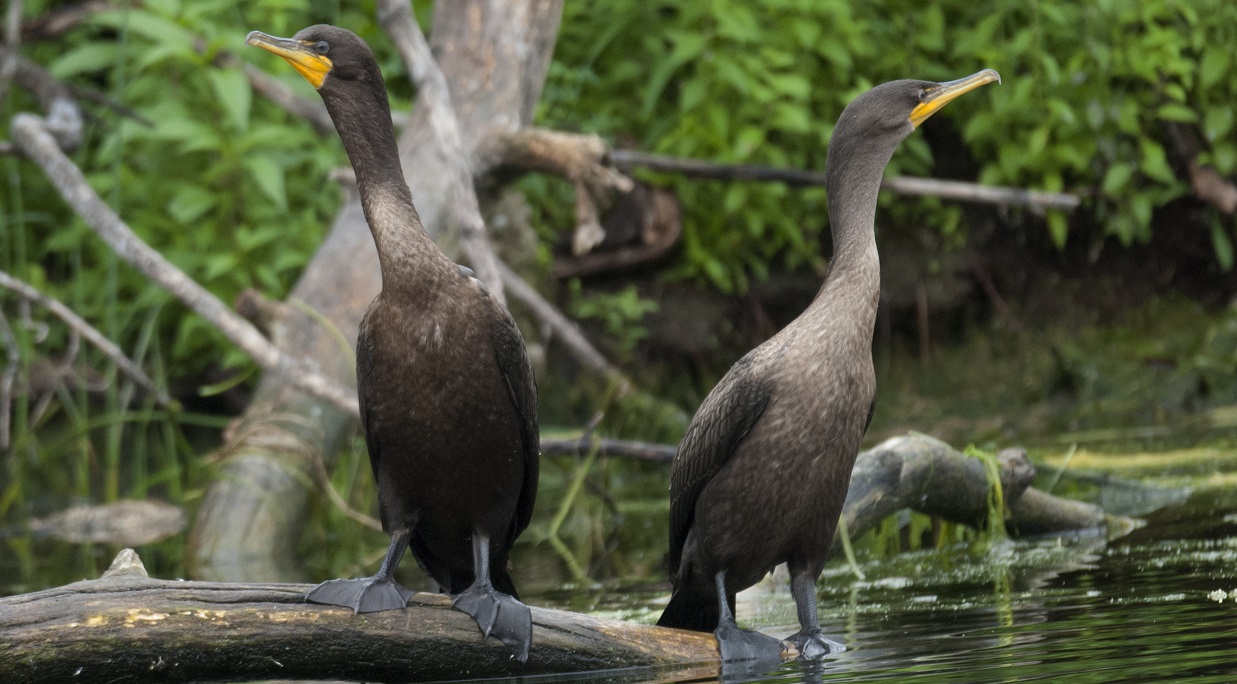
The goal of the Tommy Thompson Park Cormorant Management Strategy is to achieve a balance between the continued existence of a healthy, thriving cormorant colony and the other ecological, educational, scientific, and recreational values of Tommy Thompson Park.
Management techniques include ground nest enhancements, breeding season deterrence, and site restoration. It is a spatial management strategy that encourages ground-nesting while discouraging nesting in healthy trees. Management does not include lethal culling or egg oiling.
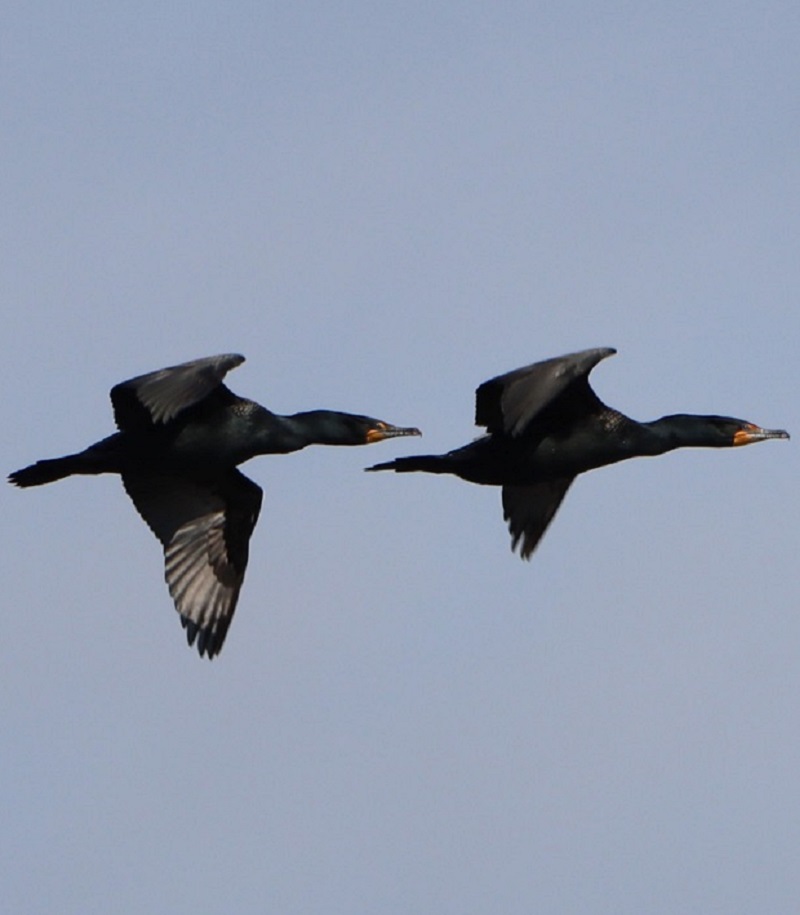
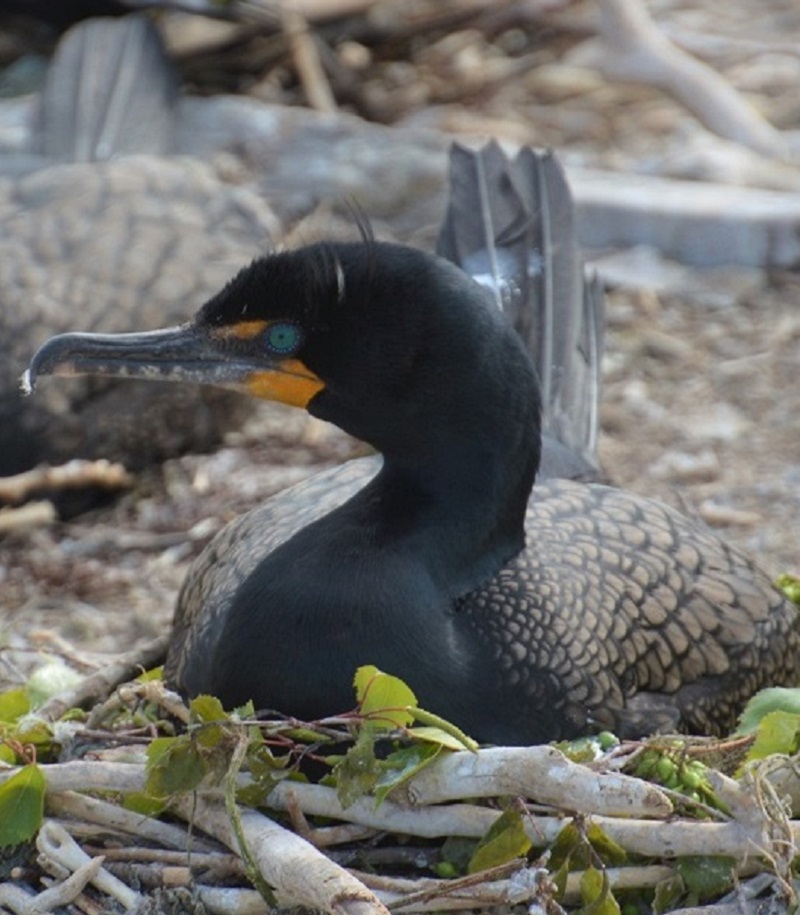
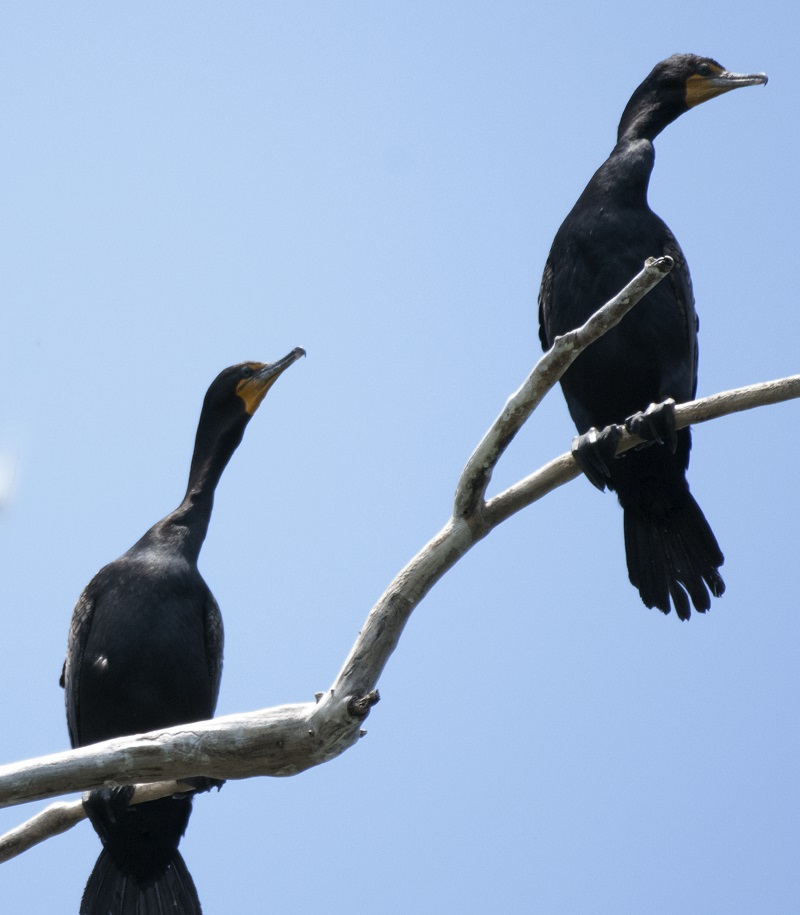
PHOTO CREDITS: Above left – Gwendolyn Clark; above centre – Gail Fraser.
Implementation of the strategy has significantly reduced tree nesting cormorants, and now more than 80% of the colony nests on the ground where they are not impacting trees.
Some cormorants, however, still want to nest in trees, so each breeding season TRCA continues with implementation of the strategy to keep cormorants out of healthy trees.
TRCA has also installed an artificial nesting structure at Tommy Thompson Park to provide alternative tree nesting opportunities.
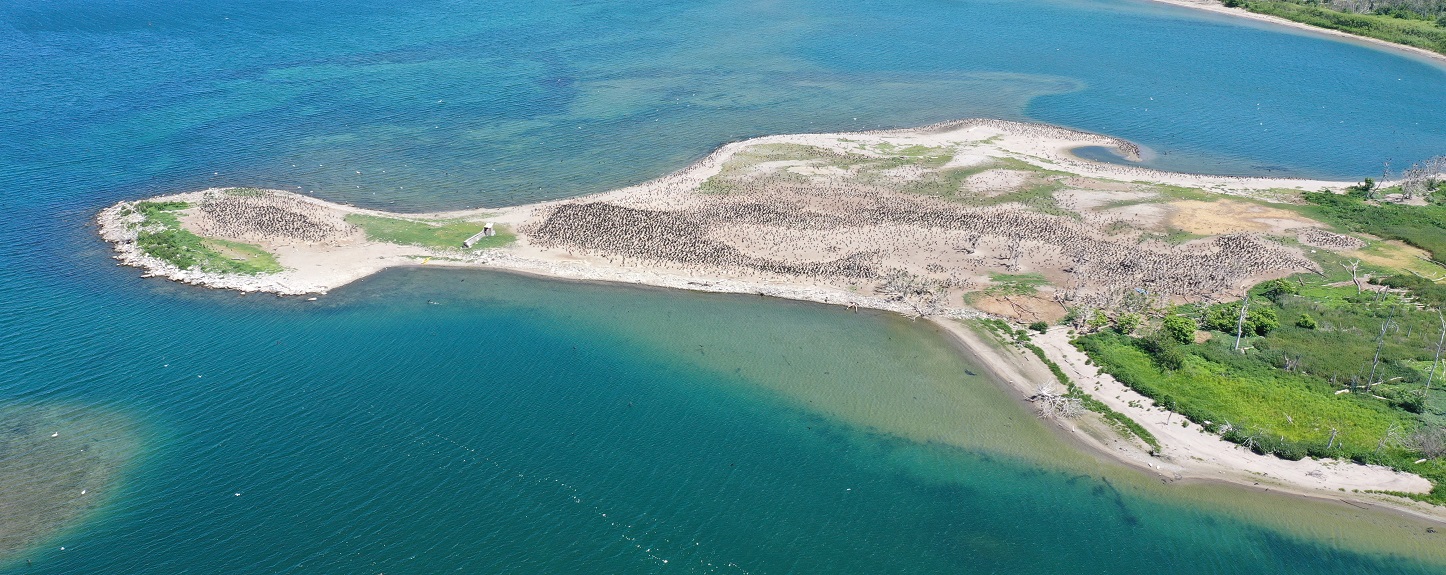
Aerial photograph of the cormorant colony at Tommy Thompson Park.
TORONTO ISLAND PARK
Cormorants started nesting at Toronto Island Park in spring 2022, causing concerns about tree loss and impact on recreational activities in the area. The City of Toronto’s Parks and Recreation team is working with TRCA to discourage cormorant nesting at Toronto Island Park.
Changing wildlife behaviour takes time, teamwork, and ongoing effort. It’s also important to watch for impacts on other animals – like Torontos first modern nesting Bald Eagles – and reduce any harm.
The ultimate goal of the management program at Toronto Island Park is to prevent any cormorant nesting. Nesting is supported in designated areas at Tommy Thompson Park. This work is being carried out with permission from the Ministry of Natural Resources.
Phase 1 – Pre-breeding Season: January through March
- The goal is to remove all nests from the previous year’s nesting area before cormorants return from their wintering grounds in late March. Nest removal eliminates a biological cue that encourages nesting, which should reduce the number of birds attracted to the park.
- Dead trees also attract cormorants to nest. Any dead trees within the nesting area are identified and removed during the winter to decrease attraction.
- Monitor nest building and behaviour of Bald Eagles. Gradually habituate the eagles to the deterrent techniques planned for cormorants in the spring.
Phase 2 – Nesting Deterrents: April through June
- A dedicated field team uses a variety of deterrent techniques to discourage cormorants from nesting in the area. They also monitor surrounding islands for new nesting locations and implement deterrents as needed.
- If nests are built, the field team monitors the nest age and takes immediate action to remove the nests while they are immature. Mature nests are left undisturbed.
- Bald Eagle behaviour is closely monitored to assess any response to cormorant deterrent activities. Deterrents are adjusted if eagles show signs of disturbance.
- Cormorant management is conducted daily from pre-sunrise to post-sunset, seven days a week, from mid-April to early June.
Phase 3 – Roosting Deterrents: July and August
- Post-breeding cormorants sometimes roost in trees outside of the nesting colony. Staff monitor the various islands for roosting cormorants and use a variety of deterrent techniques to encourage them to leave the area.
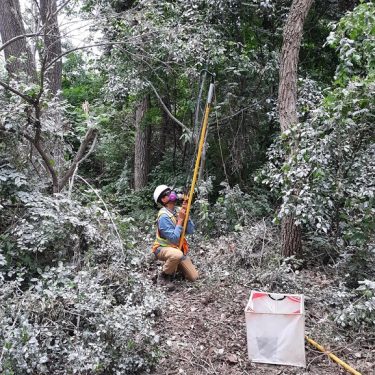
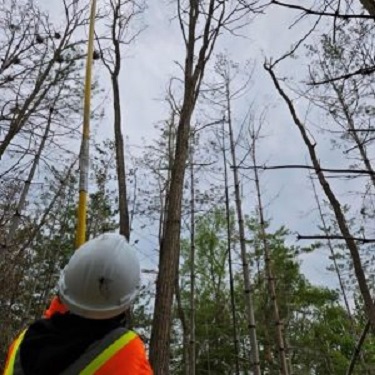
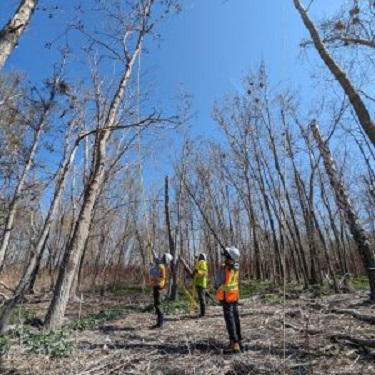
Members of TRCA’s Cormorant Management field team at work.
ANNUAL SUMMARY REPORTS
- TTP DCCO Management Report 2024
- TTP DCCO Management Report 2023
- TTP DCCO Management Report 2022
- TTP DCCO Management Report 2021
- TTP DCCO Management Report 2020
- TTP DCCO Management Report 2019
- TTP DCCO Management Report 2018
- TTP DCCO Management Report 2017
- TTP DCCO Management Report 2016
- TTP DCCO Management Report 2015
- TTP DCCO Management Report 2014
- TTP DCCO Management Report 2013
- TTP DCCO Management Report 2012
- TTP DCCO Management Report 2011
- TTP DCCO Management Report 2010
